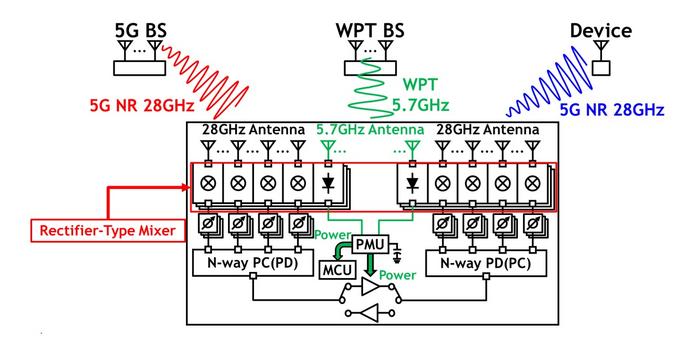A recently developed wirelessly powered 5G relay could accelerate the development of smart factories, report scientists from Tokyo Tech. By adopting a lower operating frequency for wireless power transfer, the proposed relay design solves many of the current limitations, including range and efficiency. In turn, this allows for a more versatile and widespread arrangement of sensors and transceivers in industrial settings.

Credit: 2024 IEEE Symposium on VLSI Technology & Circuits
A recently developed wirelessly powered 5G relay could accelerate the development of smart factories, report scientists from Tokyo Tech. By adopting a lower operating frequency for wireless power transfer, the proposed relay design solves many of the current limitations, including range and efficiency. In turn, this allows for a more versatile and widespread arrangement of sensors and transceivers in industrial settings.
One of the hallmarks of the Information Age is the transformation of industries towards a greater flow of information. This can be readily seen in high-tech factories and warehouses, where wireless sensors and transceivers are installed in robots, production machinery, and automatic vehicles. In many cases, 5G networks are used to orchestrate operations and communications between these devices.
To avoid relying on cumbersome wired power sources, sensors and transceivers can be energized remotely via wireless power transfer (WPT). However, one problem with conventional WPT designs is that they operate at 24 GHz. At such high frequencies, transmission beams must be extremely narrow to avoid energy losses. Moreover, power can only be transmitted if there is a clear line of sight between the WPT system and the target device. Since 5G relays are often used to extend the range of 5G base stations, WPT needs to reach even further, which is yet another challenge for 24 GHz systems.
To address the limitations of WPT, a research team from Tokyo Institute of Technology has come up with a clever solution. In a recent study, whose results have been presented in the 2024 IEEE Symposium on VLSI Technology & Circuits, they developed a novel 5G relay that can be powered wirelessly at a lower frequency of 5.7 GHz (as shown in Figure 1). “By using 5.7 GHz as the WPT frequency, we can get wider coverage than conventional 24 GHz WPT systems, enabling a wider range of devices to operate simultaneously,” explains senior author and Associate Professor Atsushi Shirane.
The proposed wirelessly powered relay is meant to act as an intermediary receiver and transmitter of 5G signals, which can originate from a 5G base station or wireless devices. The key innovation of this system is the use of a rectifier-type mixer, which performs 4th-order subharmonic mixing while also generating DC power.
Notably, the mixer uses the received 5.7 GHz WPT signal as a local signal. With this local signal, together with multiplying circuits, phase shifters, and a power combiner, the mixer ‘down-converts’ a received 28 GHz signal into a 5.2 GHz signal. Then, this 5.2 GHz signal is internally amplified, up-converted to 28 GHz through the inverse process, and retransmitted to its intended destination.
To drive these internal amplifiers, the proposed system first rectifies the 5.7 GHz WPT signal to produce DC power, which is managed by a dedicated power management unit. This ingenious approach offers several advantages, as Shirane highlights: “Since the 5.7 GHz WPT signal has less path loss than the 24 GHz signal, more power can be obtained from a rectifier. In addition, the 5.7 GHz rectifier has a lower loss than 24 GHz rectifiers and can operate at a higher power conversion efficiency.” Finally, this proposed circuit design allows for selecting the transistor size, bias voltage, matching, cutoff frequency of the filter, and load to maximize conversion efficiency and conversion gain simultaneously.
Through several experiments, the research team showcased the capabilities of their proposed relay (refer Figure 2). Occupying only a 1.5 mm by 0.77 mm chip using standard CMOS technology, a single chip can output a high power of 6.45 mW at an input power of 10.7 dBm. Notably, multiple chips could be combined to achieve a higher power output. Considering its many advantages, the proposed 5.7 GHz WPT system could thus greatly contribute to the development of smart factories.
Stay tuned for further advances in this exciting field as we dive deeper into the Information Age!
###
About Tokyo Institute of Technology
Tokyo Tech stands at the forefront of research and higher education as the leading university for science and technology in Japan. Tokyo Tech researchers excel in fields ranging from materials science to biology, computer science, and physics. Founded in 1881, Tokyo Tech hosts over 10,000 undergraduate and graduate students per year, who develop into scientific leaders and some of the most sought-after engineers in industry. Embodying the Japanese philosophy of “monotsukuri,” meaning “technical ingenuity and innovation,” the Tokyo Tech community strives to contribute to society through high-impact research.
Method of Research
Experimental study
Subject of Research
Not applicable
Article Title
A 28GHz 5GNR Wirelessly Powered Relay Transceiver Using Rectifier-Type 4th-Order Sub-Harmonic Mixer
Article Publication Date
17-Jun-2024



